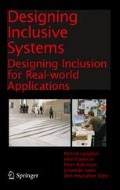Abstract
Cerebral Palsy (CP) is the commonest cause of disability among children in Europe (Johnson, 2002). Its effects and severity can be extremely varied, but a combination of arm impairments through weakness or spasticity and sensory deficits is common and can (i) significantly impair the ability of individuals with CP to carry out daily activities and (ii) create significant social barriers (Imms, 2008). Therapy is often used to aid the acquisition of motor skills, particularly in childhood, but a lack of physiotherapy resources means that this is often delivered through a self-managed home exercise programme. Exercises are frequently dull and repetitive, and children often lack the motivation to carry out these exercises, leading to poor compliance with the prescribed plan (Chappell and Williams, 2002).
Access this chapter
Tax calculation will be finalised at checkout
Purchases are for personal use only
Preview
Unable to display preview. Download preview PDF.
References
Chappell F, Williams B (2002) Rates and reasons for non-adherence to home physiotherapy in paediatrics. Physiotherapy 88(3):2–11
Deutsch JE, Borbely M, Filler J, Huhn K, Guarrera-Bowlby P (2008) Use of a low-cost, commercially available gaming console (Wii) for rehabilitation of an adolescent with cerebral palsy. Phys Ther 88(10):1196–1207
Imms C (2008) Children with cerebral palsy participate: a review of the literature. Disabil Rehabil 30(24):1867–1884
Jackson AE, Holt RJ, Culmer PR, Makower SG, Levesley MC, Richardson RC et al (2007) Dual robot system for upper limb rehabilitation after stroke: the design process. Proc Inst Mech Eng Part C :J Mech Eng Sci 221(7):845–857
Johnson A (2002) Prevalence and characteristics of children with cerebral palsy in Europe. Dev Med Child Neurol 44(9):633–640
Lanningham-Foster L, Foster RC, McCrady SK, Jensen TB, Mitre N, Levine JA (2009) Activity-promoting video games and increased energy expenditure. J Pediatr 154(6):819–823
Malone TW, Lepper MR (1987) Making learning fun: a taxonomy of intrinsic motivations for learning. In: Snow RE, Farr MJ (eds) Aptitude, learning and instructions, vol 3., Cognitive and affective process analysesLaurence Erlbaum Associates, Hillsdale, pp 223–253
Read JC (2008) Validating the fun toolkit: an instrument for measuring children’s opinions of technology. Cogn Tech Work 10(2):119–128
Sandlund M, Mcdonough S, Hager-Ross C (2009) Interactive computer play in rehabilitation of children with sensorimotor disorders: a systematic review. Dev Med Child Neurol 51(3):173–179
Sweetser S, Wyeth P (2005) Gameflow: a model for evaluating player enjoyment in games. ACM Computers in Entertainment 3(3):3A
Weightman APH, Preston N, Levesley MC, Holt RJ, Mon-Williams M, Clarke M et al (2011) Home based computer-assisted upper limb exercise for young children with cerebral palsy: a feasibility study investigating impact on motor control and functional outcome. J Rehabil Med 43(4):359–363
Author information
Authors and Affiliations
Corresponding author
Editor information
Editors and Affiliations
Rights and permissions
Copyright information
© 2012 Springer-Verlag London
About this paper
Cite this paper
Holt, R.J. et al. (2012). Deploying a Two-Player System for Arm Rehabilitation in Schools. In: Langdon, P., Clarkson, J., Robinson, P., Lazar, J., Heylighen, A. (eds) Designing Inclusive Systems. Springer, London. https://doi.org/10.1007/978-1-4471-2867-0_4
Download citation
DOI: https://doi.org/10.1007/978-1-4471-2867-0_4
Published:
Publisher Name: Springer, London
Print ISBN: 978-1-4471-2866-3
Online ISBN: 978-1-4471-2867-0
eBook Packages: EngineeringEngineering (R0)

